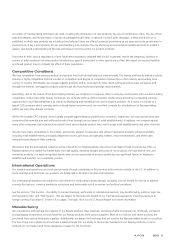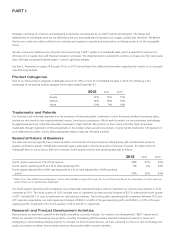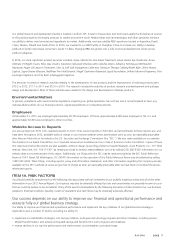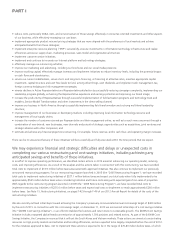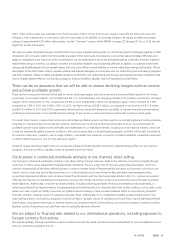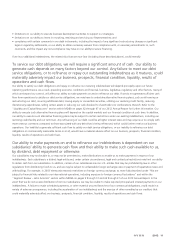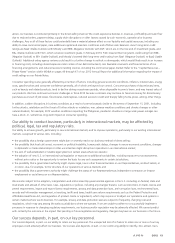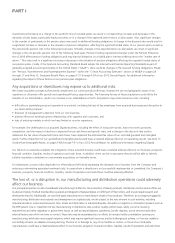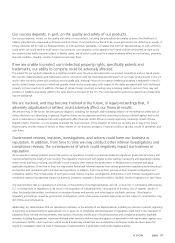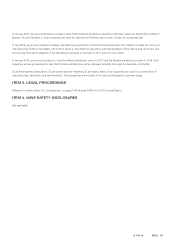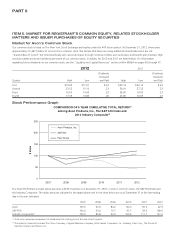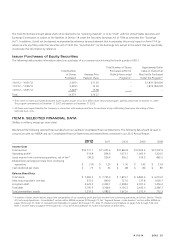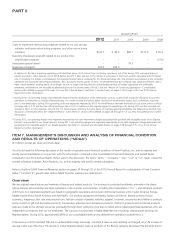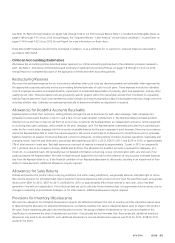Avon 2012 Annual Report Download - page 22
Download and view the complete annual report
Please find page 22 of the 2012 Avon annual report below. You can navigate through the pages in the report by either clicking on the pages listed below, or by using the keyword search tool below to find specific information within the annual report.and market new products, maintain and enhance the recognition of our brands, achieve a favorable mix of products, and refine our
approach as to how and where we market and sell our products. Consumer spending patterns and preferences cannot be predicted with
certainty and can change rapidly. There can be no assurance that we will be able to anticipate and respond to trends in the market for
beauty and related products and changing consumer demands and improve our financial results.
Furthermore, material shifts or decreases in market demand for our products, including as a result of changes in consumer spending patterns and
preferences or incorrect forecasting of market demand, could result in us carrying inventory that cannot be sold at anticipated prices or increased
product returns by our Representatives. Failure to maintain proper inventory levels or increased product returns by our Representatives could result
in a material adverse effect on our business, prospects, financial condition, liquidity, results of operations and cash flows.
A disruption of a key information technology system, process or site could adversely affect
our operations.
We employ information technology systems to support our business, including systems to support financial reporting, web-based tools, an ERP
system which we are implementing on a worldwide basis, and an internal communication and data transfer network. We also employ
information technology systems to support Representatives in many of our markets, including electronic order collection and invoicing systems
and on-line training, and utilize third-party service providers. We have Internet sites in many of our markets, including business-to-business
websites to support Representatives. We have undertaken initiatives to increase our reliance on employing information technology systems to
enable our Representatives, as well as initiatives, as part of our multi-year restructuring programs, to outsource certain services, including the
provision of global human resources information technology systems to our employees and other information technology processes.
Any of these systems may be susceptible to outages or disruptions due to the complex landscape of localized applications and architectures
as well as incidents due to legacy or unintegrated systems or both, fire, floods, power loss, telecommunications failures, terrorist attacks,
cyber security breaches, break-ins, corruption and similar events. There may be other challenges and risks as we upgrade, modernize, and
standardize our information technology systems, such as through Service Model Transformation, on a worldwide basis. In addition, in the
third quarter of 2011, we experienced challenges in implementing an ERP system in Brazil which impacted service levels, which in turn
negatively impacted average order and Active Representative and revenue growth during 2011. Despite our network/ cyber security
measures, our systems may also be vulnerable to computer viruses, data or cyber security breaches, break-ins, corruption and similar
disruptions from unauthorized tampering with these systems. The occurrence of these or other events could disrupt our information
technology systems and adversely affect our operations, as well as cause damage to our reputation, financial obligations to third parties,
fines, penalties, regulatory proceedings and private litigation with potentially large costs, and could also result in deterioration in our
employees’ and customers’ confidence in us and other competitive disadvantages.
Third-party suppliers provide, among other things, the raw materials used to manufacture our
Beauty products, and the loss of these suppliers or a disruption or interruption in the supply
chain may adversely affect our business.
We manufacture and package the majority of our Beauty products. Raw materials, consisting chiefly of essential oils, chemicals, containers
and packaging components, are purchased from various third-party suppliers for our Beauty products. All of our Fashion and Home products
are purchased from various suppliers. Additionally, we produce the brochures that are used by Representatives to sell Avon products. The
loss of multiple suppliers or a significant disruption or interruption in the supply chain could have a material adverse effect on the
manufacturing and packaging of our Beauty products, the purchasing of our Fashion and Home products or the production of our
brochures. This risk may be exacerbated by our globally-coordinated purchasing strategy, which leverages volumes. In addition, regulatory
action, such as restrictions on importation, may also disrupt or interrupt our supply chain. Furthermore, increases in the costs of raw
materials or other commodities may adversely affect our profit margins if we are unable to pass along any higher costs in the form of price
increases or otherwise achieve cost efficiencies in manufacturing and distribution.
Significant changes in pension fund investment performance, assumptions relating to pension
costs or required legal changes in pension funding rules may have a material effect on the
valuation of pension obligations, the funded status of pension plans and our pension cost.
Our funding policy for pension plans is to accumulate plan assets that, over the long run, will approximate the present value of projected
benefit obligations. Our pension cost is materially affected by the discount rate used to measure pension obligations, the level of plan assets
available to fund those obligations at the measurement date and the expected long-term rate of return on plan assets. Significant changes in
A V O N 2012 15


